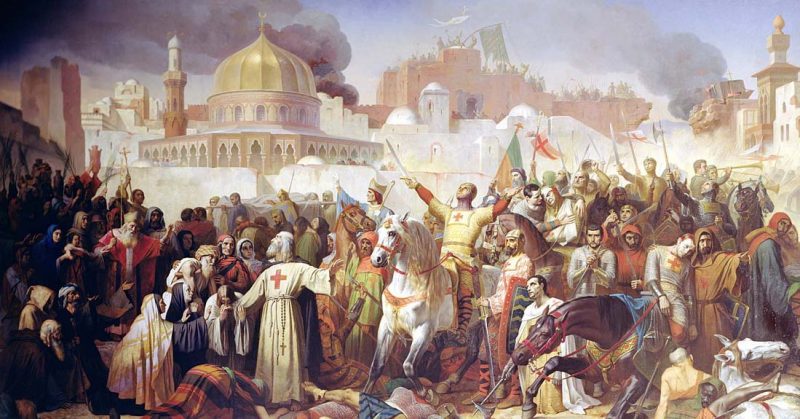Few cities have been the scene of so much conflict as Jerusalem. Countless battles and sieges have been fought for the capital of the Holy Land. These following is a list of the 12 most significant sieges.
The Siege of Jebus (c.1000 BC)
The first recorded siege of Jerusalem siege, involved the taking of the city, by the Jews from the Canaanites.
According to the Old Testament 1 Book of Chronicles, the Israelites under King David captured the city of Jebus from the Jebusites, a Canaanite tribe. David renamed the city, Jerusalem and made it his capital city. However, a lack of evidence for the existence of Jebus has led many to believe that Jebus did not exist or was located elsewhere.
The Assyrian Siege (701 BC)
In the late 8th century BC, the Assyrian King Sennacherib invaded the kingdom of Judah, whose capital was then Jerusalem. Accounts from the two opposing sides differ. Assyrian sources state that the Jews were trapped and hopeless in Jerusalem, while Jewish sources record the Assyrians suffering heavy casualties. Both agree that the city was not taken. If the Assyrians had taken the city this could have changed the history of the Jewish people.
Nebuchadnezzar II’s Two Sieges (597 and 587 BC)
In 587 BC the Babylonian King Nebuchadnezzar II besieged and conquered Jerusalem, then installed a young puppet ruler named Jeconiah, who was in turn replaced by Zedekiah. Zedekiah rebelled against Babylon, allying himself with the Egyptians.
Nebuchadnezzar would not stand for this. He once again invaded and surrounded Jerusalem. The city fell after either one-an-a-half or two-and-a-half years of siege. In vengeance for the revolt, and as a deterrent to others, Nebuchadnezzar had the city burned to the ground and its citizens taken away into captivity. It was only with the rise of the Persian Empire, that the Jews were allowed to return to Jerusalem and rebuild their Temple, c 500 B.C.

a painting by David Roberts (1796-1849).
Pompey’s Siege (63 BC)
In 67 BC Salome Alexandra, the Queen of Judea, died. Her two sons, Hyrcanus II and Aristobulus II, quickly fell to fighting each other for control of the kingdom. At the time, the Roman general Pompey was in the region, fresh from his success in the Third Mithridatic War. When both sides appealed to the Romans to settle their dispute, Pompey took the opportunity to intervene.
Having asked for Pompey’s judgement, Aristobulus would not wait for it, but instead shut himself in a fortress. His supporters refused to let Pompey and his troops into Jerusalem, and so the Romans besieged the city. A three-month siege was ended when the Romans breached the defences and stormed the city.
Following the fall of Jerusalem, to Pompey, Judea lost much of its territory and became a satellite state of Rome.
Herod the Great’s Siege (37 BC)
23 years later, Judea once again descended into civil war. Antigonus II, backed by invading Parthian forces, took the throne from Herod the Great.
His rival claimant, Herod, travelled to Rome in search of support. Roman forces helped him retake Judea, ending with the 40 day Siege of Jerusalem in 37 BC. Herod’s supporters and Roman troops under Marc Anthony stormed the city. The Romans went on a rampage, doing much damage to the city that their ally intended to rule. Herod later rebuild the city.
Titus’s Siege (70 AD)
66-73 AD saw the first of three major Jewish revolts against their Roman overlords. During the suppression of this revolt, the future Roman Emperor Titus besieged Jerusalem with four legions in 70 AD.
The Jewish rebels known as Zealots stood little chance. Divided and disorganised, their leaders were at war with each other as well as the Romans. The Romans, on the other hand, were masters of siege engineering. The city was conquered and once again pillaged, the Second Temple burned down and the population of the city exiled or enslaved.
First Muslim Siege (637 AD)
In the early 7th century, Arab followers of the new religion Islam, were sweeping all before them. Heading northwest, they invaded Palestine and Syria provinces of the Byzantine Empire..
In 636, the Byzantine Emperor Heraclius was defeated by the Arabs at the Battle of Yarmouk. As a result, the Byzantines could do nothing to help Jerusalem when it was besieged the following year. A largely bloodless siege lasted several months, after which the city surrendered to the Caliph Umar, who travelled there especially to receive the surrender.
The First Crusade (1099 AD)
The siege during the First Crusade is perhaps the most infamous. A force of European nobles, knights and foot soldiers seized the city in a two-pronged assault after a month’s siege. Allegedly in the Holy Land to protect the Christian community and sacred places from the Muslims, the Crusaders engaged in atrocities after they took the city. The majority of the city’s Muslims and Jews were butchered, and chronicles, from the time, record crusaders wading up to their knees in blood.
Saladin’s Siege (1187 AD)
Following the First Crusade, Jerusalem became the capital of a new crusader kingdom, for several decades. In 1187 the Muslim general Saladin besieged the city. For nearly two weeks the city’s defenders suffered constant rains of arrows and frequent assaults, which they repulsed. But it was clear that they would lose, and so they surrendered. In contrast with the previous conquest, there were no massacres, and Christian defenders were allowed to leave after paying a ransom.
The Khwarezmian Siege (1244 AD)
In the late 1220s, the Holy Roman Emperor Frederick II invaded the Holy Land. Jerusalem and other cities surrendered to him without a fight. He promised religious toleration and equal treatment for all people, irrespective of their faith.
In response, the Muslim Ayyubids rulers of Egypt, invited the Khwarezmians, nomads from Central Asia, who had lost their lands to the Mongols, to retake Jerusalem. The Khwarezmians besieged the city and captured it, but the results were not what the Ayyubids wanted, as the besiegers destroyed the city.
The Peasant Siege (1834)
In 1834, Palestinian peasants rose up in revolt against the occupying Egyptians. The Egyptians had revolted from Ottoman rule. The then invaded Palestinian, but this was resented by the local people. 6-7,000 Arab peasants besieged Jerusalem, which was defended by 2,000 Egyptian soldiers.
After repulsing an initial rebel attack, the garrison withdrew into the castle, allowing the rebels to occupy the city for several days. The rebels themselves, running out of supplies then retreated, and the Egyptians emerged to reoccupy Jerusalem.
